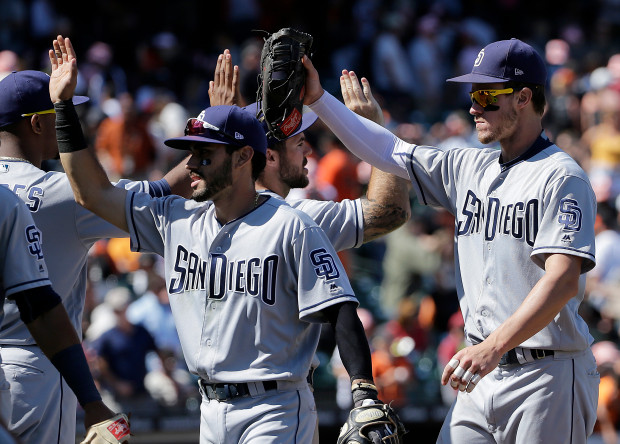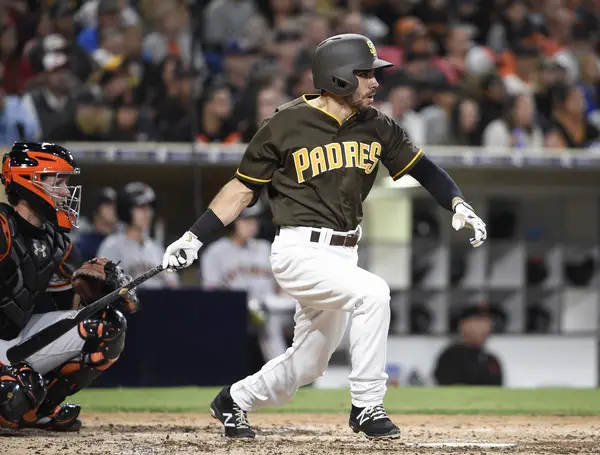Carlos Asuaje an Improved Hitter Following Return from El Paso

(AP Photo/Jeff Chiu)

It was a pretty nightmarish start of the season for Carlos Asuaje — Who was hitting below the Mendoza line and even admitted publicly on twitter that he had been playing very poorly. He was sent down to Triple-A El Paso shortly thereafter, and spent about a month and a half there from May through June. Upon his July 1 recall to the Padres, Asuaje immediately started hitting really well. So far, he’s looked like a vastly improved and much more disciplined hitter than he was in April and May. Take a look at the differences in his performances before and after his time in El Paso:
| Date | BB% | K% | ISO | AVG | OBP | SLG |
| 3/29 – 5/19 | 8.3% | 16.5% | .092 | 0.193 | 0.256 | 0.284 |
| 7/1 – 7/23 | 16.9% | 25.4% | .125 | 0.313 | 0.424 | 0.438 |
While he has been striking out more often, Asuaje is walking a lot more than he used to, and is more importantly being a more dangerous hitter. The first reason for the second baseman’s resurgence, is his improved plate coverage. This is what has allowed him to get on base so often, and punish mistakes that pitchers make around the plate. Check out his Statcast heat map of pitches to see how pitchers facing him changed their locations because of how well he’s been hitting:

As you can see, in the early part of the season pitchers were unafraid to attack Asuaje in the strike zone. Now, they are being more timid with their pitching and working away much more often than they were previously. Clearly they have noticed that he’s been such a good hitter lately, because their pitching shows that they’re becoming more weary of him.
Though Asuaje has also made a key mechanical tweak to his swing, that has really helped him make more consistent contact, and do more damage at the plate. Watch his pre-pitch setup during an April 4 game against the Rockies:

Notice that his front foot is basically aligned with his back foot — And his bat is held in a fairly stiff and rigid position as he prepares for Jon Gray‘s offering. Once the pitch is about to be delivered, Asuaje lifts his front foot. He looks as if he’s rushing his swing because he isn’t getting his foot down early enough. He then rolls over Gray’s pitch because he is rushing to make contact.
Fast forward to July and his recall from Triple-A, and Asuaje has a more calm, prepared approach at the plate before the pitch is thrown by Jacob deGrom:

The most significant difference in his swing is that he’s opened up his front foot in his stance. He’s also holding the bat in a more relaxed, slightly more upright position. Asuaje is looking noticeably more comfortable at the plate, even when facing an ace pitcher like deGrom. He also gets his foot down earlier, beginning to raise it at a much earlier point in time than he was in the previous gif.
Another factor that really influenced the way Asuaje performed in the first half were his launch angles on batted balls. After all, he had an average launch angle of 10.4 degrees on base hits — During the beginning of the season before he was sent down. It certainly didn’t seem to help his batting average, even though a ten degree launch angle average would seem normal for the contact hitting second baseman he’s considered to be. In contrast to some players on the team like Hosmer and Margot who have struggled when elevating their batted balls, Asuaje has found more success when doing so.
Since his recall on July 1, Asuaje’s average launch angle on base hits has been 17.8 degrees. It’s interesting that he has improved when elevating the ball more, while guys like Hosmer who would seem like better fits for launch angle changes — Have played miserably when trying to make the same kind of adjustments. If there’s something to learn about the whole idea of launch angles here, it’s probably that we can’t really know who will improve as a result of making a change in their swing. With Asuaje in mind, we can’t even pick out specific types of hitters as good or bad candidates for making a launch angle increase.
As a whole, Carlos Asuaje has started to take much better at-bats than he was earlier in the season. He is more disciplined and patient at the plate, waiting for a pitch he can do damage with or taking a walk. He’s striking out more often than he did beforehand, but this is acceptable because he’s a better hitter overall now. The evolution of Asuaje has been really interesting to follow — When he debuted with the Padres in late 2016, he was a slap-hitting second baseman who played pretty middling defense. In 2017 he improved his defense and became a regular at the keystone for San Diego in the second half of the season. Since struggling with the bat this year, and then finding his stroke recently, Asuaje is looking like the best version of himself we’ve seen.
A sophomore at Willamette University in Oregon, Conrad is majoring in Spanish but is also a writing center assistant for other students at Willamette. He has been a Padres die-hard his whole life and hopes to bring comprehensible statistical analysis to the site.
Can’t believe Green is playing a .220 hitter over Pirela (.260)
Sorry Pirela haters, just have to go with the numbers.
Would like to see them bring Urias up and platoon Asuaje and Villanueva at third. I think their split differences versus L/R are pretty stark.